Archive for August 2017
STUDY: Even Very Low Levels of Air Pollution Increase Mental Illness in Children
 Most of us are used to hearing about the traditional physical ailments caused by breathing poisoned air, and even about the more recently-connected neurological impacts. But a new Swedish study is the first time we’ve seen a report linking air pollution to mental illness in children.
Most of us are used to hearing about the traditional physical ailments caused by breathing poisoned air, and even about the more recently-connected neurological impacts. But a new Swedish study is the first time we’ve seen a report linking air pollution to mental illness in children.
The new research, peer reviewed and published by the journal BMJ Open, found that relatively small increases in air pollution were associated with a significant increase in treated psychiatric problems. Its conclusions are consistent with a growing body of evidence that air pollution can affect mental and cognitive health.
Two things about this study stand out: 1) How rigorous it was. It examined the exposure levels of over 500,000 Swedish kids under 18 for more than three years; 2) The very low levels of air pollution linked to increased diagnosis and treatment. This is a familiar story, but it’s driven home by a new correlation to mental illness. The more we examine the impacts of toxins on people, the more we understand there is no “safe level” of exposure we can count on. The variety of nuanced adverse health effects will not be as obvious as cancer or asthma. Instead they might show up as depression, or the inability to conceive.
The pollutants studied were Particulate Matter and Nitrogen Dioxide. There’s already a large body of evidence linking PM pollution to neurological diseases and learning disabilities. Tiny PM uses the body’s bloodstream as a highway to hitchhike its way to any organ. Since so much of our blood goes to our brain, it’s not surprising that so many brain functions are affected by it.
“The results can mean that a lower concentration of air pollution, first and foremost from traffic, may reduce psychiatric disorders in children and adolescents,” said Anna Oudin, at Umeå University, who led the study. “I would be worried myself if I lived in an area with high air pollution.”
But has her own study shows, you don’t have to live in areas with “high air pollution” to be impacted.
“Giving Day” is Only 3 Weeks Away
 THURSDAY, SEPTEMBER 14th
THURSDAY, SEPTEMBER 14th
8 am to 12 Midnight
DFW is our home office. We’re entirely local.
Giving Day provides us with a large part of our annual budget.
It’s a great chance to support local grassroots clean air work.
DFW is in its 26th year of continuous violation of the Clean Air Act.
This Giving Day, please consider a contribution of at least $26 to Downwinders at Risk.
Giving Day Pay Portal, active at 8 am on 9/14:
https://northtexasgivingday.org/npo/downwinders-at-risk-education-fund
Cowtown Redux for “21st Century Air Monitoring” Sept 7th
 If you missed our “Science and Socializing” series of roll-out events for the DFW Air Research Consortium in June, you have a chance to catch the show again on Thursday September 7th when the Fort Worth League of Neighborhoods is using its September monthly meeting to host a repeat performance.
If you missed our “Science and Socializing” series of roll-out events for the DFW Air Research Consortium in June, you have a chance to catch the show again on Thursday September 7th when the Fort Worth League of Neighborhoods is using its September monthly meeting to host a repeat performance.
Dr. David Sterling and Graduate Assistant Leslie Allsop of UNT Health Science Center, as well as Downwinders at Risk Director Jim Schermbeck are the featured speakers.
In just a little over a year, the Air Research Consortium has grown in both size and ambition since being co-founded by Downwinders and local university professors to push the goal of a dense grid of sensors for DFW providing more detailed real time information on air quality than the status quo. At last count, the cities of Dallas, Fort Worth, and Plano had joined, along with UTD, TCU, UNT, UNTHSC, UTA, Liveable Arlington, and Mansfield Gas Awareness.
Although the group’s proposal to the National Science Foundation for funding a grid pilot project next year didn’t get selected over the summer, it did make it to the final round and give the members confidence in the idea. New sources of support for the grid are being explored, and more cities are adopting this more comprehensive approach to monitoring.
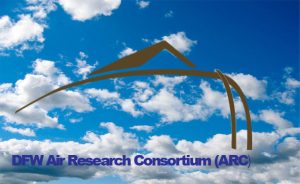
Meanwhile, two other Consortium projects are moving forward.
One is matching ten Particulate Matter and Ozone sensors with as many local public schools in Fort Worth, Dallas. Richardson and Plano. The other is Downwinders’ own Wise County Ozone Project, which commits two ozone monitors to a place no state ozone monitor has ever been.
Building the Consortium’s air monitoring grid has become a major goal of Downwinders because of its potential to give citizens a powerful new tool. Our on-going job is to figure out how best to integrate this new sensor technology into our traditional community organizing model to get change faster on the ground. We truly believe this new kind of air monitoring can change the way people “see” air pollution and how it impacts their lives.
But don’t take our word for it. Come see the presentation on the 7th and decide for yourself.
Meet Our New Scientist
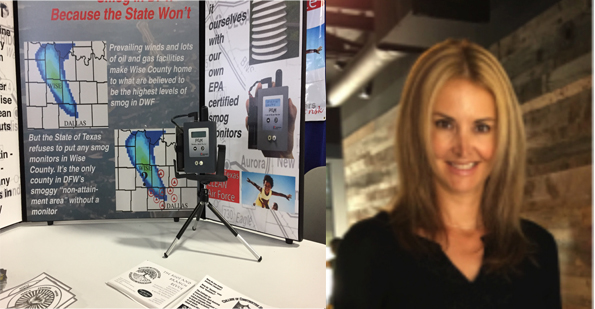 Downwinders’ Wise County Ozone Project Gets A Director
Downwinders’ Wise County Ozone Project Gets A Director
Downwinders at Risk is proud to announce Kari Northeim, a doctoral student in Environmental Sciences at the University of North Texas, has agreed to become our Wise County Ozone Project Director.
Kari brings an impressive resume and a rigorous level of scientific methodology to the use of our two new EPA-calibrated portable ozone monitors we purchased earlier this year.
She has an undergraduate degree in Engineering from Iowa State, has two more years at San Francisco State studying Meteorology, including climate change modeling and global warming research. Still not satisfied, she went and got a Business degree at Syracuse, worked in the private sector for 16 years, went back to teach High School science, and is now pursuing a PhD. in Environmental Science – Biological Sciences with an emphasis on Health Geographical Information Systems. Did we mention Kari has an impressive resume?
But it’s more than accumulated degrees. Kari’s father and all of her siblings are engineers, while her mom is a math teacher. Number crunching is in her blood. And she wants to use those mad skills to help the environment and people. So instead of making small fortunes for Wall Street firms or multinationals, she’s helping non-profits do original research in smog pollution.
How did we find her? She found us. Following her UNT adviser’s advice to catch the presentations on 21st Century air quality monitoring featured in Downwinders’ series of Evenings of Science and Socializing last June, she drove down to Fort Worth, saw the show, and stayed to talk. It’s a great outreach event when it snags this kind of talent (and courtesy of the Ft. Worth League of Neighborhoods, you have a chance to see a repeat of that Cowtown performance September 7th – see the notice below).
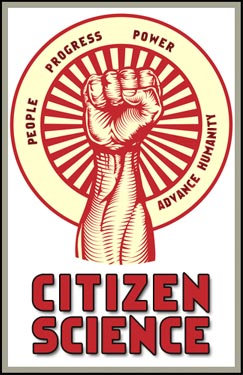 Believed to be the largest, or at least most ambitious citizen-science project in North Texas, Downwinders’ Wise County Ozone Project is going where no state or federal monitoring for smog has gone before: into the only DFW “non-attainment” county without an ozone monitor.
Believed to be the largest, or at least most ambitious citizen-science project in North Texas, Downwinders’ Wise County Ozone Project is going where no state or federal monitoring for smog has gone before: into the only DFW “non-attainment” county without an ozone monitor.
Wise County is where fracking was born and the gas industry still dominates many parts of it. It’s also where a lot of everyone else’s smog accumulates. Predominant southeast winds push it from the Gulf Coast all the way to Midlothian, through the metro DFW area, and into Wise County.
Based on past computer modeling by the State itself, ozone levels are often predicted to be higher in Wise County than any other 10 DFW non-attainment counties – but there’s still no State monitors there.
That gap in local public health information is intentional and it’s that gap the Wise County Ozone Project is filling.
Northeim is already drafting plans on how best to put the monitors to the test in the field. She wants us to have the ability to use them as stationary monitoring sites, as well as be able to take them with us on the road. It’s a complex and long-term mission that Northheim says she relishes. And she’ll be putting out the “Help Wanted” sign soon as she recruits other citizen scientists and volunteers to help, so stay tuned. You too can become a citizen scientist for the public interest.
Finding Kari was a real coup. But from its founding, Downwinders has had a long and distinguished history of working with great scientists and using sound science to advance the cause of cleaner air.
Dr. Marvin Legator’s 1996 report on the State’s toxicity classification system eventually led to some changes in Austin. Dr. Stuart Batterman did a landmark public health critique of the TXI hazardous waste burning permit in the late 1990’s. Dr. Al Armendarez, an engineering professor at SMU when he started out as Downwinder’s technical adviser, left in 2009 to become the first engineer ever to be appointed as Regional Administrator for EPA. In 2015, Dr. Kuruvilla John of UNT’s Physics Department used that school’s supercomputers to reproduce the state’s air modeling for DFW outside of Austin for the first time so elected officials could see what impact new pollution controls would have.
Soon-to-be Dr. Kari Northeim is the latest effort by Downwinders to develop local DFW expertise to help solve DFW air pollution problems. Please join us in welcoming her to the cause and consider signing-on to what is sure to be another historic challenge to the Status Quo.
Why Cement Kilns are Insatiable. And Why You Care.
 Dow, Hefty and Keep America Clean’s proposal to burn plastics via bright orange “energy bags” in cement kilns is new but the idea of using kilns as industrial kitchen dispose-alls is not.
Dow, Hefty and Keep America Clean’s proposal to burn plastics via bright orange “energy bags” in cement kilns is new but the idea of using kilns as industrial kitchen dispose-alls is not.
DFW has been identified as a national waste disposal destination because of its cement plants since at least the mid 1980’s. And as long as they continue to operate, the area will continue to be seen as a desirable dumping ground.
All these buildings, and roads, and “developments” have to be made out of something. They’re mostly made out of cement. In an area that’s grown by a Tyler or Richardson a year since 1970, cement is as ubiquitous as the air in your lungs. You just take it for granted. But it comes from somewhere and it gets made someplace.
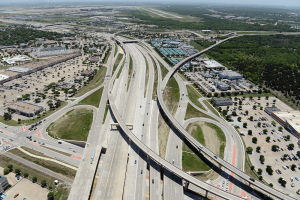
Brought to you by…Cement!
In our case, that place is here – right over there, in Midlothian, just a couple of miles across the Dallas and Tarrant County lines to the south. You know, the direction the wind blows from most of the time.
And its a big place. There’s a Chamber of Commerce sign in downtown Midlothian proclaiming the town the “Cement Capitol of Texas.” There are three large cement plants – TXI, Ash Grove and Holcim – that quarry the limestone rock they need from the escarpment that runs north-south along I-35 for most of the length of the state. But the sign is too modest. Befitting one of the fastest growing areas in the country, it’s the largest concentration of cement manufacturing in the nation.

The Chamber of Commerce sign in downtown Midlothian
These aren’t batch plants. Think coal plants. Smokestacks hundreds of feet high. Furnaces, or kilns, as long as football fields. In 2015, the three plants released 475 tons of Particulate Matter pollution, 2040 tons of Sulfur Dioxide, and 510 tons of Volatile Organic Compounds – more pollution than the totals from entire North Texas counties.
That pollution goes somewhere. Depending on where you live, some of it lands in your lungs.
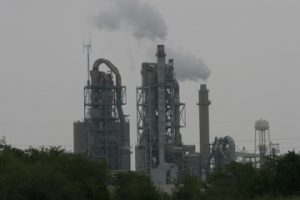
Holcim – one of three Midlothian cement plants
All three cement plants are in Midlothian to mine the limestone rock just like coal plants would strip-mine coal. Midlothian has a lot of cement kilns because that’s where the raw material for cement is, not because of any other reason.
But unlike coal, the limestone isn’t flammable and for there to be cement, the kilns must reach and maintain a flame of at least 1700 degrees F to bake the limestone with other ingredients. This is the way cement has been made since Rome perfected the process two millennia ago. You bake rock…just so.
And that flame is your number one operating expense as a cement plant owner. It accounts for up to 40% the costs of doing business. Anything you can do to reduce the costs of that flame saves you money. And that equation is the basis of constant mischief in the industry.
When the first Midlothian cement plant opened in 1960, and when the second one opened in 1965, the rock was baked with fire fueled by Texas natural gas. By the time the third cement plant opened in the mid-1980’s , the first couple of “energy crisis” had hit and they all three begun to burn cheaper coal.
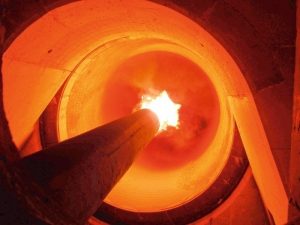
The lance of the flame inside a cement kiln, or furnace
But another trend started in the 1980’s. Two of the three cement plants took advantage of a loophole in a new federal law and began burning hazardous wastes to bake their limestone rock.
Unlike gas and coal, the cement plants were paid by hazardous waste generators and middlemen to burn these wastes, so the plants not only saved the cost of buying fuel, they actually profited from becoming incinerators, and labeling waste as “fuel.” Hazardous waste burning at U.S. cement plants peaked in the 1990’s.

Air computer model of where the smog pollution from all three Midlothian cement plants goes during a typical year
Even after many cement plants have stopped burning hazardous wastes, they continue to burn “industrial wastes” like used oil, tires and shredded car interiors. When burned in kilns, these waste often produce exactly the same toxic air pollution as hazardous wastes. That’s what’s happening in Midlothian now. Although decades of citizen action have modernized the equipment and stopped the burning of official hazardous waste, the three cement plants continue to burn a wide variety of materials, and the pollution continues to blow wherever the wind takes it.
As long as there’s limestone to be mined, the cement plants will remain open in Midlothian. As long as they stay open in Midlothian, they’re going to try to burn all kinds of wastes. When they do, they release a lot of toxic air pollution. And as long as the wind patterns stay the same that means that seven million DFW residents will be exposed to that toxic air pollution.
And that’s the reason why DFW is always just one multinational decision away from being downwind of a huge hazardous waste incinerator again, or a municipal waste incinerator, or a medical waste incinerator: Because we’re already downwind of the three hungry cement plants that need to burn any and everything they can get their hands on, the cheaper the better. And if they can get paid to throw things in the fire, well that’s a business formula they can get behind. As long as they need to feed their flames, they’re out combing the streets for things to burn – including “hard to burn plastics” for an industry that needs its own greenwashing cover story.
Until the manufacturing of cement no longer demands a sun-hot flame, or they run out of limestone rock, the Midlothian cement plants pose pose a huge on-going air pollution threat. The Dow project to burn plastics is just the latest, but not last, chapter. That’s why as long as there’s cement being made here, there also needs to be vigilant downwinders.
DFW EJ Issues Get Some Muscle

New Attorneys and Paralegals Give Citizens Options
We know things look bleak right now. There are few bright spots. You wonder if every new possible small light you see is the end of the tunnel…or another train about to run you over.
Which makes what’s happening at the North Texas Legal Aid offices remarkable and worth knowing about.
For the first time in anyone’s memory, there are two attorneys, and at least that many paralegals, specifically dedicated to providing “free legal services, advocacy, and community education to individuals, community groups, and non-profit organizations” working on Environmental Justice issues.
And not just Environmental Justice. Fair and affordable housing, as well as more democratic and equitable community development now have many more local advocates than they did just a few months ago.
In essence, DFW citizens just got their own legal defense fund amped up to 11.
Legal Aid is an independent federal nonprofit established by Congress in 1974 to provide financial support for civil legal aid to low-income Americans. As long as you meet the agency’s income criteria, you have access to free legal services and resources (income up to 125% of the U.S. poverty line. In certain cases up to 200%). Both Dallas and Fort Worth have had under-staffed, under-budgeted offices for years, but still managed to do good work.
Representing rural residents of “Cement Valley,” a Dallas Legal Services lawyer, Robert Doggett, was co-counsel in Downwinders’ fight against the TXI hazardous-waste burning permit throughout the 1990’s. But that kind of direct participation in a high-profile environmental fight has been rare. These fresh hires are looking to change that.
As part of the newly-funded “Community Revitalization Project,” these attorneys will be providing “assistance and education to communities and individuals on how to use the law to ensure fair treatment and meaningful involvement of all people—regardless of race, color, national origin, or income—with respect to the government’s development and implementation of environmental policies, as well as the enforcement of environmental laws and regulations against polluters. The objective of CRP is to help ensure that all communities provide the opportunity for residents to live in a clean and healthy environment.”
In addition, staff will also assist “individuals and communities in developing and maintaining affordable housing, fighting housing discrimination and other illegal housing practices, and meaningfully participating in the development and implementation of policies that affect their neighborhoods. The goal is to help ensure that individuals and communities have equal access to affordable, accessible, and safe housing.” They’ll help to “educate citizens about their right to offer meaningful input on matters affecting their communities. CRP also works with communities to advocate for economic justice, develop fair access to transportation, fight predatory lending practices, and address systemic inequalities commonly found in low-income communities.”
 New lawyers from the Project are landing in other major Texas cities as well. There’s potential to do a lot of good here.
New lawyers from the Project are landing in other major Texas cities as well. There’s potential to do a lot of good here.
Moreover, the budgets for these new positions are not subject to Presidential, Congressional or state political tantrums. They’re funded for at least the next four years with money from a multi-million dollar settlement from “legal claims arising from mortgage-related activities by Bank of America and its subsidiaries.”
The monies are distributed by a third party, the Texas Access to Justice Foundation. They can’t be messed with. There’s hope of making the Project’s positions and mission permanent after the settlement money runs its course.
The result is a palpable shift in power. While it’s not close to matching the firepower of a government agency legal department or a polluter’s white shoe legal team, the presence of the the Legal Services effort in town means North Texas residents now have access to an extraordinary network of legal help they didn’t have just a few months ago.
And if our own organizational history tells us anything, it’s that a determined critical mass can make a huge difference against much larger and more powerful opponent.
Tulane graduate Matthew Miller is the Legal Service’s Project’s point person in DFW. His email is: millerm@lanwt.org
Don’t be shy. Use your imagination. It doesn’t have have to be a lawsuit. It can be as simple as a Open Records Act request, or sitting in on a meeting with officials. They want to be our legal counsel. Let’s make effective use of this new tool.
